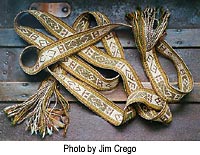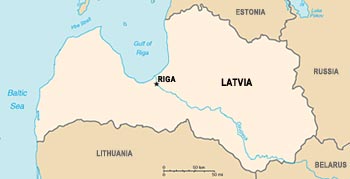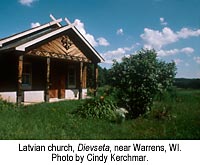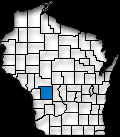Home | Search | The Artists | Teaching | Hiring | About This Site | Contact Us

Vera and Mara’s
Main Page

Latvian Weaving
Warrens, WI
 What
have you learned from your mother? What did your mother learn from your
grandmother?
What
have you learned from your mother? What did your mother learn from your
grandmother?
Vera and Mara Mednis are mother and daughter. They come from a family in which a mother teaches her daughter how to weave. This happened for generations in Latvia, and then again when the family moved to Wisconsin. Today, Vera and Mara love to weave together. They have continued their family’s Latvian weaving tradition, but they also have woven in their own sense of beauty.
Vera’s Journey

Vera was born in Riga, Latvia in 1939. When she was four, her family was evacuated, because the Soviet Union was beginning to occupy their country. Vera’s family lived in German refugee camps until she was eleven.
In 1951, the director of a local hospital in Wauwatosa, WI sponsored her family so they could immigrate to the United States. Vera’s family first came to Milwaukee, like many of the other Latvians who fled their country and moved to Wisconsin.
Vera’s family always hoped to return to Latvia once it was free from foreign-rule. While in Wisconsin, they continued living in traditional Latvian ways. They cooked things like brown peas and sourdough rye bread and spoke the Latvian language. When Vera was thirteen, her mom, Emma, started teaching her how to weave.
Building a Latvian Life in America
After Vera grew up, she married a Latvian man named Edmunds Mednis in 1959. Edmunds was a silversmith who created beautiful jewelry. He and Vera dreamed of living in a rural area and creating art to make their living. In 1977, they moved from Milwaukee to Warrens.
Vera made Latvian regional costumes and Latvian-styled pottery. In addition to jewelry, Edmunds learned leatherwork from Vera. Vera and Edmunds were successful and were able to make a living as artists.
 About thirty other Latvians lived in the Warrens area when Vera and Edmunds first
arrived. Edmunds helped construct a church where they could congregate
and celebrate nature-centered beliefs. They called the church Dievseta, or
“God’s homestead.” Dievseta became a place where these Latvian-Americans could gather, sing, build
mid-summer
bonfires, and talk about their beliefs.
About thirty other Latvians lived in the Warrens area when Vera and Edmunds first
arrived. Edmunds helped construct a church where they could congregate
and celebrate nature-centered beliefs. They called the church Dievseta, or
“God’s homestead.” Dievseta became a place where these Latvian-Americans could gather, sing, build
mid-summer
bonfires, and talk about their beliefs.
Weaving the next generation
In 1962, Vera and Edmunds had a daughter and named her Mara. Vera taught Mara everything she knew about Latvian textiles. She taught her to loom weave and card weave. Vera taught her daughter about the Latvian designs and color choices she had learned from her own mother a generation earlier.
By the time Edmunds died in 1989, Mara had inherited a strong ethnic heritage from both her mom and dad. She had learned traditional handwork, traditional ways to celebrate holidays and traditional Latvian techniques.
Today, Vera and Mara weave together as a mother- daughter team. They demonstrate their weaving skills and traditions at folklife festivals, community festivals, and Latvian art events.
For Educators:
Send us
your class presentations for our Showcase!
Home | Search | The Artists | Teaching | Hiring | About This Site | Contact Us
